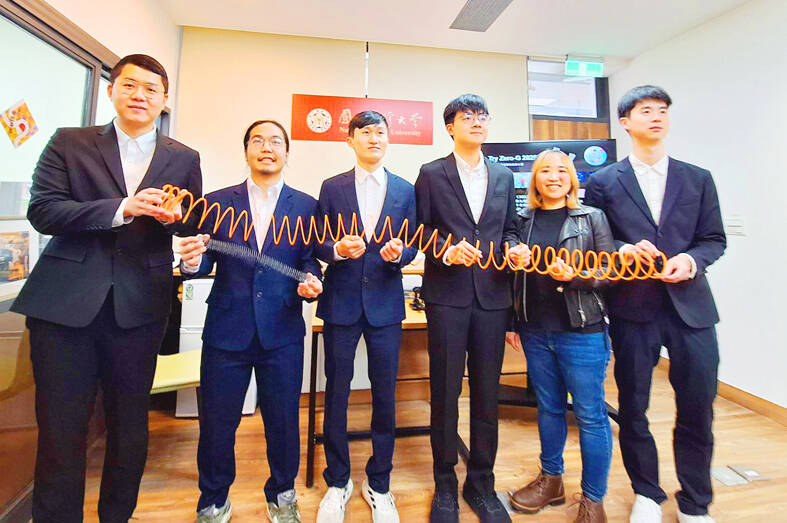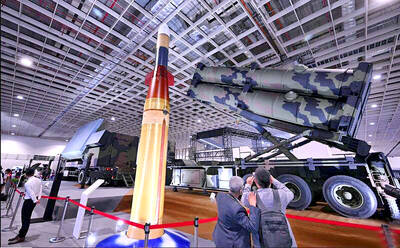A Slinky-inspired fluid dynamics experiment proposed by students from National Taiwan University (NTU) would be carried into space by the Japan Aerospace Exploration Agency (JAXA) late this year or early next year.
The NTU student project, titled “The Liquid Waltz: Observing Fluid Dynamics in a Dancing Slinky,” was one of 11 topics selected in the final round of the Asian Try Zero G 2025 (ATZ-G 2025) mission organized by JAXA, the Japanese national space agency said in a news release on March 24.
Having received 500 proposals in the first round from students in nine countries in the Asia-Pacific region, ATZ-G 2025 seeks “experiments that enable visual confirmation of physical phenomena,” to be conducted by a Japanese astronaut aboard the International Space Station (ISS) some time in the second half of this year or early next year, JAXA said.

Photo: CNA
Chen Wen-ching (陳文慶), a member of the five-person NTU student team calling themselves the “Slinky Ninjas,” on Wednesday said that the forces that control liquids on Earth do not necessarily apply in space.
To explore the difference, the team came up with the idea of using a Slinky and a water pouch to observe how liquid moves when poured into a spring-like structure in a weightless environment, aiming to see whether surface tension and Laplace pressure could create an “invisible force” to stabilize the liquid inside the coils, he said.
Chen said that preliminary experiments showed surface tension could confine liquid within a Slinky-like spiral structure at small scales, whereas at larger scales, such as that of a full-sized Slinky, gravity causes the liquid to escape through the gaps.
The team hopes that in the microgravity environment of the ISS, when the Slinky is stretched, twisted, or bent, the liquid would continue to flow seamlessly within it, he added.
When those movements occur during each stretch of the experiment, “an astronaut holding both ends of the Slinky is like performing a waltz in space,” he said, explaining the inspiration behind the project’s name.
The team envisions future applications of the fluid control technology in industries such as semiconductors, pharmaceuticals and even space colonization, Chen said.
Chiang Ya-yu (蔣雅郁), an associate professor at NTU’s Department of Mechanical Engineering who leads the team, said the project ranked first among the 67 proposals submitted from across Taiwan and went on to represent the country in the final stage of ATZ-G 2025, which evaluated the technical feasibility of 27 short-listed topics.
The NTU student project received high praise from the astronauts involved in the selection process, including Japanese astronaut Satoshi Furukawa, who conducted the selected experiments in the previous edition of ATZ-G aboard the ISS in 2023, Chiang said.
ATZ-G was first launched in 2011, with ATZ-G 2025 marking the ninth edition of the event, joined by 1,176 students from nine countries, including Taiwan, Japan, Singapore and Australia.

Taiwan is to commence mass production of the Tien Kung (天弓, “Sky Bow”) III, IV and V missiles by the second quarter of this year if the legislature approves the government’s NT$1.25 trillion (US$39.78 billion) special defense budget, an official said yesterday. Commenting on condition of anonymity, a defense official with knowledge of the matter said that the advanced systems are expected to provide crucial capabilities against ballistic and cruise missiles for the proposed “T-Dome,” an advanced, multi-layered air defense network. The Tien Kung III is an air defense missile with a maximum interception altitude of 35km. The Tien Kung IV and V

The disruption of 941 flights in and out of Taiwan due to China’s large-scale military exercises was no accident, but rather the result of a “quasi-blockade” used to simulate creating the air and sea routes needed for an amphibious landing, a military expert said. The disruptions occurred on Tuesday and lasted about 10 hours as China conducted live-fire drills in the Taiwan Strait. The Civil Aviation Administration (CAA) said the exercises affected 857 international flights and 84 domestic flights, affecting more than 100,000 travelers. Su Tzu-yun (蘇紫雲), a research fellow at the government-sponsored Institute for National Defense and Security Research, said the air

Taiwan lacks effective and cost-efficient armaments to intercept rockets, making the planned “T-Dome” interception system necessary, two experts said on Tuesday. The concerns were raised after China’s military fired two waves of rockets during live-fire drills around Taiwan on Tuesday, part of two-day exercises code-named “Justice Mission 2025.” The first wave involved 17 rockets launched at 9am from Pingtan in China’s Fujian Province, according to Lieutenant General Hsieh Jih-sheng (謝日升) of the Office of the Deputy Chief of the General Staff for Intelligence at the Ministry of National Defense. Those rockets landed 70 nautical miles (129.6km) northeast of Keelung without flying over Taiwan,

A strong continental cold air mass is to bring pollutants to Taiwan from tomorrow, the Ministry of Environment said today, as it issued an “orange” air quality alert for most of the country. All of Taiwan except for Hualien and Taitung counties is to be under an “orange” air quality alert tomorrow, indicating air quality that is unhealthy for sensitive groups. In China, areas from Shandong to Shanghai have been enveloped in haze since Saturday, the ministry said in a news release. Yesterday, hourly concentrations of PM2.5 in these areas ranged from 65 to 160 micrograms per cubic meter (mg/m³), and pollutants were